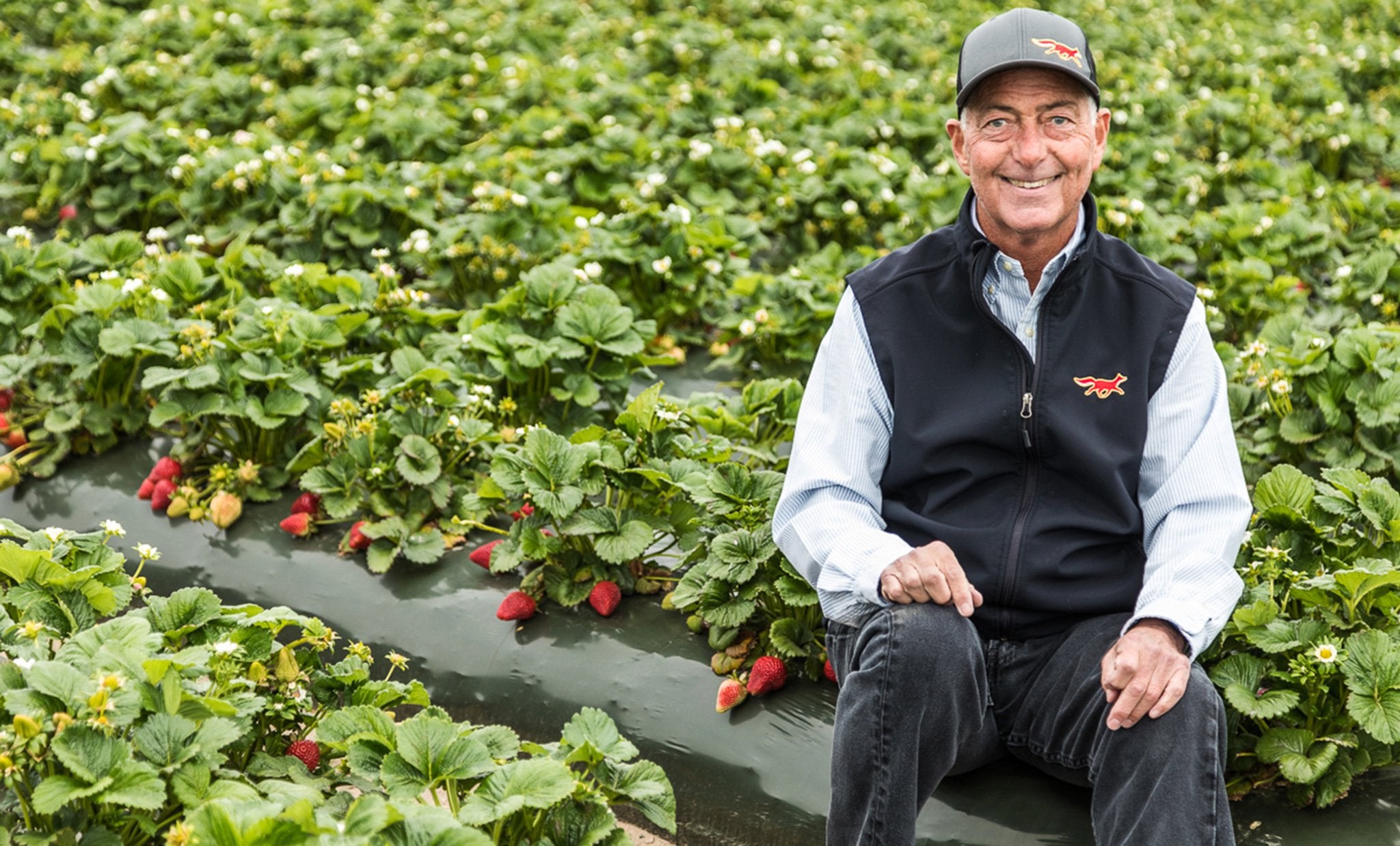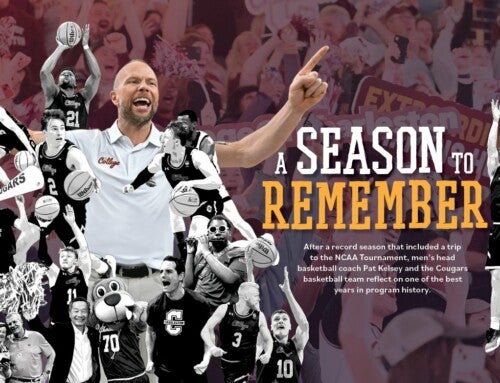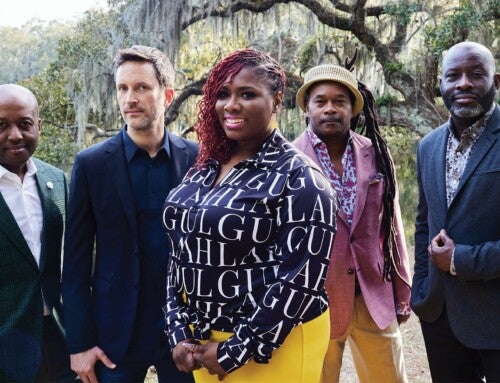The 90-mile Salinas Valley stretches inland from Monterey, California, to east of San Luis Obispo. A mild climate and fertile soil combine to make it “the salad bowl of the world,” growing 70% of the nation’s lettuce, along with strawberries, broccoli, cauliflower and artichokes. To the west are the Santa Lucia Mountains, which rise abruptly and steeply from the Pacific Ocean; to the east the Gabilans, “beckoning mountains with a brown grass love,” as John Steinbeck wrote in East of Eden. The highest point at 3,455 feet is Fremont Peak, named after one of the most accomplished alumni of the College, John Fremont, Class of 1836, who built a log fort on the hillside in 1846. Known as the “Great Pathfinder,” he helped open the West and was instrumental in the conquest and development of California.

Scott Blazer explains how the direction of the sun affects the growth of strawberries in the field. (Photos by Lisa Corson)
Another alumnus rode into this valley in 1985 and reached a peak of a different kind, earning his own nickname in the process. Scott Blazer ’79 rose to the top of the produce industry as “the Strawberry King.” The company he co-founded in 1996, Blazer Wilkinson, which began as a strawberry distributor and broker, is one of the country’s leading growers, packers and shippers of premium strawberries under the Foxy brand. The company sells about 150 million pounds every year from coast to coast and has made Blazer a very successful businessman.
“It’s been filled with a lot of hours of hard work,” he says. “Brokering was easier than being a grower-shipper, but being a grower-shipper is much more prestigious. It’s the ultimate goal because you are the product, but growers have all the risk because it’s your money in the ground.”
That was particularly true this past winter when historic rains inundated the state with repeated flooding, causing hundreds of millions of dollars in crop damages. Blazer Wilkinson Gee, as it’s now known, has about 700 acres of fields in the Salinas Valley, along with another 1,000 acres in Southern California, 800 acres in Florida and 400 acres in Mexico. A visit with Blazer in his pickup truck to one of the company’s damaged fields in the Salinas Valley reveals rows of strawberry plants still caked with dried mud weeks after the last flood. The last things you want on your strawberry crop are water and dirt, so a muddy flood is a double whammy. Even their fields that weren’t flooded were affected by all the rain and unseasonably cool temperatures, stunting overall production by 50% and wreaking havoc with deliveries to retailers like Publix, Costco and Aldi.
“Definitely the worst I’ve ever seen in my career,” sighs Blazer, peering out the window of his pickup.
Strawberry Fields Forever
Blazer maneuvers his truck through the town of Salinas on the way to look at a field farther east from the Salinas River that wasn’t flooded. A sign bearing his company name and the Foxy logo hanging from a big red post marks the entrance. The sun is shining bright, but there’s a nip in the air as harvest manager Michael Ortiz leads a tour. Thousands of small leafy plants protruding through 48-inch-wide mounds covered with black weed barrier stretch out in all directions. Most plants are still in the flowering stage due to the weather, but others have the reddest, biggest strawberries you’ve ever seen (the first fruits explode with flavor and size because of all the stored-up nutrients). In the organic section, Ortiz demonstrates the proper way to pick one (twist, don’t pull), and the taste is spectacular. Timing is the key to a good harvest.
“The berry has to be perfect before we pick it,” says Ortiz, whose father oversees the drip irrigation and whose mother supervises the work crews.
The plants will go on to produce fruit all spring and summer, making strawberries a real cash crop because of the large yield on a relatively small piece of land. Each acre holds about 20,000 plants, which produce about 800,000 strawberries annually, but the profit can vary widely depending on a variety of factors such as weather, labor shortages and fuel costs.
Although harvesting in Salinas is still a few weeks away, it’s well underway a couple of hours south in Santa Maria, Blazer’s next stop, where he enjoys mingling with the workers who call him el jefe (the boss). A couple dozen are scattered among the rows. With wheeled buggies in tow, they quickly probe each plant for ripe berries, which they then place directly in the Foxy clamshell. The speed and puzzle-building skill with which they pack about 20 strawberries into a clamshell is a bit of a marvel. Each worker, who can make as much as $20 an hour plus health insurance and an incentivizing “piece rate” during peak harvest, can pack about 650 clamshells in a typical day. When their cart is full, they bring it over to an inspection station where other workers do quality control on each clamshell before placing eight of them into a box, or flat, which they then scan for traceability and sustainability.
By his own admission, Blazer is not a farmer. With the twinkle in his eye and ebullient personality, his strength is sales and fostering relationships. “He’s never met a stranger,” says his sister, Cindy, who talked him into coming out to Bakersfield, California, after graduate school to work for her then-husband, a vegetable broker. “He had so much personality and was so good looking. That Southern charm knocked everybody off their feet.”

A worker picks and packs strawberries in the field while rolling a cart that holds a flat of clamshells of berries.
He might not say “yes, sir” and “no, ma’am,” like he did when he was growing up in Charleston, but he’s retained all the other attributes of a Southern gentleman – conversant, kind, polite, attentive, respectful and empathetic – even after 40 years in California. That personal touch is one of the reasons Blazer has done so well in the state’s competitive produce industry.
“I enjoy producing a product that people say all the time how much they love, and that they know it’s me,” he says. “There’s some ego, but not as much ego as just satisfaction – living up to your promise to yourself and to the promise you made to the buyer.”
All-American Guy
The youngest of five children, Blazer grew up primarily in downtown Charleston on Laurens Street. His dad, Sanford Deems “Jack” Blazer Jr., was a developer who lost it all after overextending himself in Summerville real estate when Scott was about 10. Scott got his work ethic at an early age. To earn money, he would open a self-serve laundromat early in the morning, cleaning out the lint traps and soap dishes; after classes at the Cathedral Grammar School, he delivered The Evening Post on his bicycle and was responsible for collecting payment from customers.
He had a mischievous side, too. He and his friends used to smoke and read Playboy in a treehouse they built across from Moultrie Playground. They would also follow the Coburg Dairy milkman on his delivery route to swipe the Krispy Kreme donuts, which he also delivered, off porches, including the one belonging to U.S. Sen. Fritz Hollings.
“And if you had chocolate milk, I’d take that too,” recalls Blazer with a laugh. “And then we’d go back to the tree fort and eat them up there. But then the tree caught on fire when we were learning how to smoke. There was a picture of it on the front page of The News and Courier.”
His dad, who passed away when Blazer was 14, was a Citadel grad, but Blazer enrolled at the College after graduating from Bishop England High School. He had been living on his own at the carriage house on Laurens Street for a few years by then, since his mother, Catherine, had moved to Cordesville, South Carolina, near Moncks Corner, after she married R.W. Blouin, a Coast Guard captain.
“I will never forgive my mother for that because she abandoned him,” says Cindy, who was living in Summerville, working as a bank teller. “Scotty didn’t know that’s what he felt at the time. He thought he was a big boy put in charge of the house, but he’d just started high school.”
Cindy worried about him all the time, but Blazer is nothing if not self-sufficient. He did well at the College, majoring in political science and pledging Kappa Alpha fraternity, where he met his lifelong friends, Ken Corbett ’79 and Chris Cochran ’79. He made the political science national honor society, Pi Sigma Alpha, and was inducted into Omicron Delta Kappa honor society for his leadership abilities and community contributions.
“I just remember how sharp and brilliant he was and how willing he was to help pull a guy like me across the finish line by helping me study for exams,” says Corbett, a real estate attorney. “He was also very athletic, good looking and just a joy to be around. He’s still the same as he was then – personable, straight up, honest and kind, the kind of guy you count as one of the treasures in your life.”
Cochran helped Blazer land a coveted job at Marianne, a French restaurant on Meeting Street. “He was just the most dapper and excellent waiter, very hard worker and a good multitasker,” recalls Cochran, a building contractor. “He was very wise for his age. He picked one girl and stuck with her when all of us had a number of different girlfriends. He’s the original all-American guy. He was just the kind of guy you would want to know.”
He had a bit of showman in him, too, something his brother, Tom, found out when he came into Marianne one night for dinner. Wearing the restaurant’s trademark blue-and-white French apron, Blazer was in his element interacting with customers and making flambés tableside.
“It was the first time I saw him as a different person, not a sack of smelly tennis shoes,” says Tom, who’s 10 years older. “He was cool, and that ability to interact with people carried over into his working life.”

Strawberries and flowers in various states of growth. Each field is picked multiple times throughout the growing season.
The Berry Broker
Blazer had plans of working in the foreign service and attended the international studies graduate program at the University of South Carolina, but he took off for Bakersfield in his rickety Mazda RX-7 before completing his thesis. Cindy’s husband, Manny Lawrence, told him there was money to be made brokering vegetables: “Get out here.”
After an apprenticeship, it wasn’t long before Blazer was brokering every kind of fruit and vegetable and every kind of lettuce, too. But working for his brother-in-law, a former drill sergeant at Fort Ord, an Army outpost in Monterey, California, wasn’t easy.
“He was an extraordinary tactician,” recalls Blazer. “But everything had to be exactly right, from the way an order was written to the way you talked on the phone. He taught me the discipline of produce, who’s bad, who’s good, how to handle this situation, that situation.”
The one piece of produce his brother-in-law couldn’t quite get his arms around was strawberries, so Blazer gave them a go, and he quickly found his niche. He moved to the Salinas Valley area a few years later to escape the heat of Bakersfield and get to the heart of the produce industry, where he was better able to establish relationships with the generational families of produce growers. Business was good because Blazer was so good at relationship building (the guy has the gift of gab). A turning point came in 1994 when a buyer at Albertsons went to work for Walmart, which had just started selling groceries.
“I’m going to work at this place in Arkansas,” he told Blazer. “They don’t do produce, but we’re going to be really big, and you’re going to help us get there.”
It was a big moment, says Blazer. “It’s probably the factor that put me over the top as the main strawberry broker in the industry once I had that buying power.”
He took the account with him when he and a friend, John Wilkinson, started their own brokerage company two years later. They made $50,000 the first week and soon landed Sam’s Club, Costco (then Price Club) and Wegman’s.
Shipping strawberries all over the country is no easy task, however, because if their temperature gets above 34 degrees Fahrenheit, they can spoil. Sensors in the container can alert the company to a problem, but a buyer can reject a shipment if more than 15% don’t pass inspection. (A typical truckload holds about 3,000 flats or 24,000 clamshells.) In 2005, Blazer created the carrier contract that became the industry standard to maintain the cold chain through transit, shelf life and sale.
“It’s a risky business,” says Blazer. “Sam’s Club will reject them if they’re 40 degrees even if they’re perfect because they don’t trust the shelf life.”
Blazer Wilkinson got into farming in 2003. They soon transitioned to growing strawberries with produce giant Foxy, who knew how much Blazer Wilkinson could bring to the table – a sterling reputation, for starters. Buyers like Denny’s restaurants ate the strawberries up to the tune of half a million pounds over a three-month period.
“Scott was always honest and upfront,” says Gene Harris, Denny’s produce buyer. “I didn’t have to validate what he was telling me. He was a great mentor who educated me about the process. He’s just a good guy who loves sharing his knowledge. I’m grateful to call him my friend.”
Epilogue
Blazer sold most of his share of the company last summer when a big investor made an offer he couldn’t refuse, but there is still a Blazer at the company: his son, Zach, who is in awe not only of his dad’s sales abilities where everyone feels like a winner, but also of his feel for the market.
“The guy’s a wizard,” says Zach. “He’s very good at anticipating not only your next email, but what your needs are going to be over the next six months. There’s a multitude of questions that he’s right about 99% of the time.”
His old fraternity buddies aren’t the least bit surprised by his success. “He took off in that old beat-up Mazda with his brother Bubba,” says Cochran. “He probably didn’t have two nickels to rub together at the time, and he became a gazillionaire. I’m just so proud of him I can’t stand it.”
Despite his fortune, Blazer isn’t ostentatious. He doesn’t wear fancy designer clothes, and he lives in a relatively modest stucco house in Salinas. It does have a pool, and he bought himself an electric Porsche Taycan for his 65th birthday, but those are about his only extravagances. Some life moments that include the passing of his wife, Eva, in 2015 have kept him humble, too, although he was “blessed” to start dating Loly Hogans, a veterinary surgeon, in 2018.
He does plan more frequent visits back to the Lowcountry now that he’s semi-retired, but he has no plans to move back. “For a long time, I missed home because this is nothing like it,” he says. “Southern charm was not always appreciated here. People took awhile to get used to me opening doors for them, but this is my home now; these are my people. To come so far, it’s been quite an adventure.”





